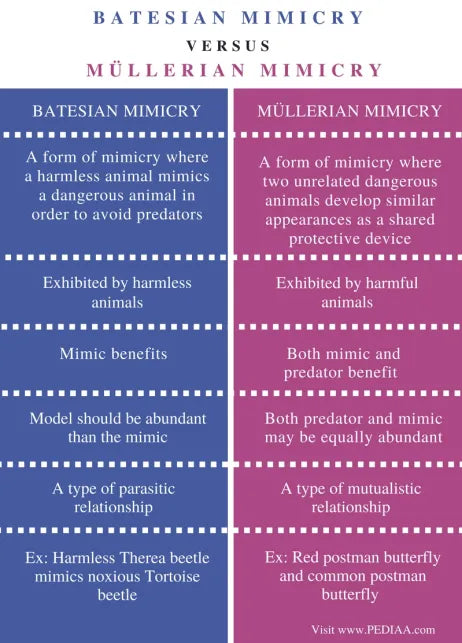
Hey there, butterfly enthusiasts! Let’s jump into the seeing isn’t always believing world of butterfly mimicry…
Butterflies are often celebrated for their delicate beauty and vibrant colors. But beyond their aesthetic appeal lies a fascinating world of evolutionary tricks, the most intriguing of which is mimicry. Imagine being able to survive just by looking like someone – or something – else. That's the essence of mimicry, and butterflies are masters of this deceptive art.
*A Game of Life and Death*
For butterflies, mimicry isn't just about blending in; it's often a matter of life and death. Predators, especially birds, are constantly on the lookout for a tasty butterfly snack. To avoid becoming lunch, some butterflies have evolved to look like other, less palatable species. This evolutionary strategy, known as Batesian mimicry, is all about fake it till you make it – or in this case, till you avoid being eaten.
Take the classic example of the Viceroy and the Monarch butterflies. Monarchs are toxic due to the milkweed they consume as caterpillars. Birds know this and generally avoid them. The Viceroy butterfly, which isn’t toxic, has evolved to look remarkably similar to the Monarch. This clever disguise fools predators into steering clear, granting the Viceroy a much better chance of survival.
*More Than Just a Pretty Face*
But mimicry in butterflies goes beyond just dodging predators. There's also Mullerian mimicry, where two or more unpalatable species evolve to resemble each other. This isn't about bluffing; it’s about reinforcing the idea that bright, bold patterns mean a bad taste. Both species benefit because predators learn more quickly to avoid them, reducing the likelihood of any butterfly being eaten. It's like a mutual agreement in the butterfly world – the more, the merrier, and the safer.
Consider the Heliconius butterflies. These tropical beauties sport strikingly similar patterns of black, red, and yellow. Each of these species is genuinely toxic, so when predators encounter one, they learn to avoid that pattern altogether. It’s a win-win situation: the more species that share the warning signal, the more effective it becomes.
*Sex and Survival*
Mimicry can also be a tool for reproductive success. In some species, female butterflies have evolved to mimic other species to avoid harassment by males. This form of mimicry ensures they can go about their business of laying eggs without constant interruption. It's a fascinating twist on the theme – instead of avoiding predators, they're avoiding potential mates!
*The Complexity of Mimicry*
What makes mimicry truly fascinating is its complexity. It's not just about looking like another species; it involves behavior, habitat, and timing. Some butterflies will only mimic certain species in specific regions where their look-alikes are found, adapting their patterns to match the local "models." This dynamic adaptation showcases the incredible versatility and intelligence encoded in butterfly genetics.
*A Lesson from Nature*
Mimicry in butterflies is more than a survival strategy; it's a testament to the ingenuity of natural selection. It reminds us of the intricate and interdependent relationships in ecosystems. These delicate insects, through their art of deception, teach us about the endless possibilities of adaptation and evolution.
So next time you see a butterfly flitting by, take a closer look. You might just be witnessing one of nature’s greatest con artists in action, living proof that sometimes, looking like something you're not is the best way to thrive in a world full of dangers.
Happy butterfly watching!!
